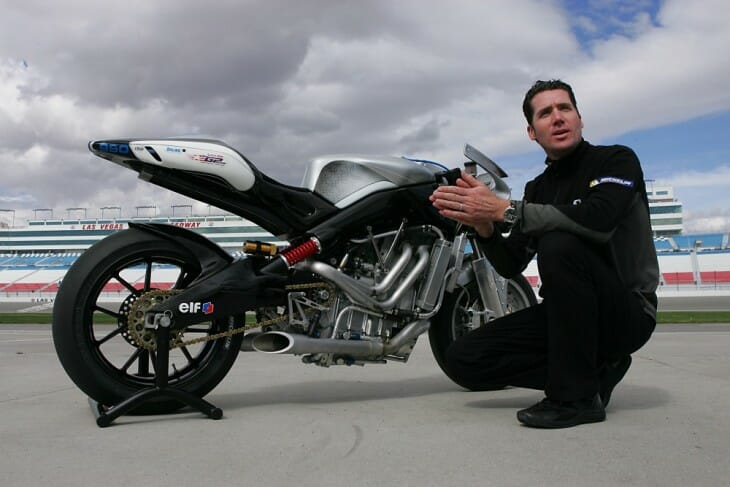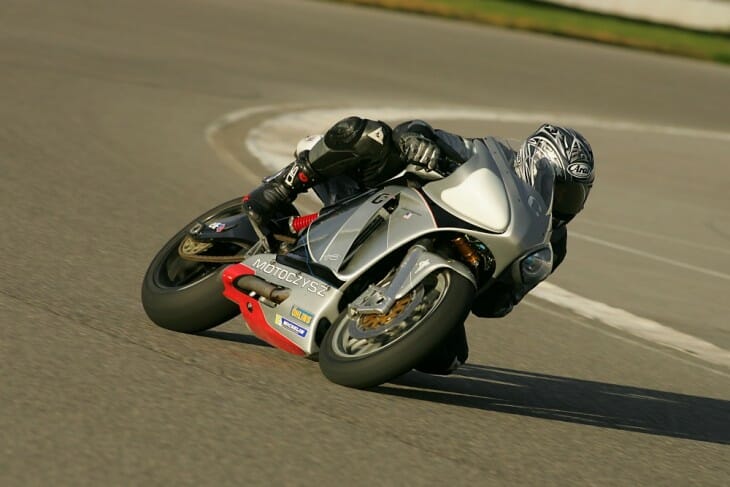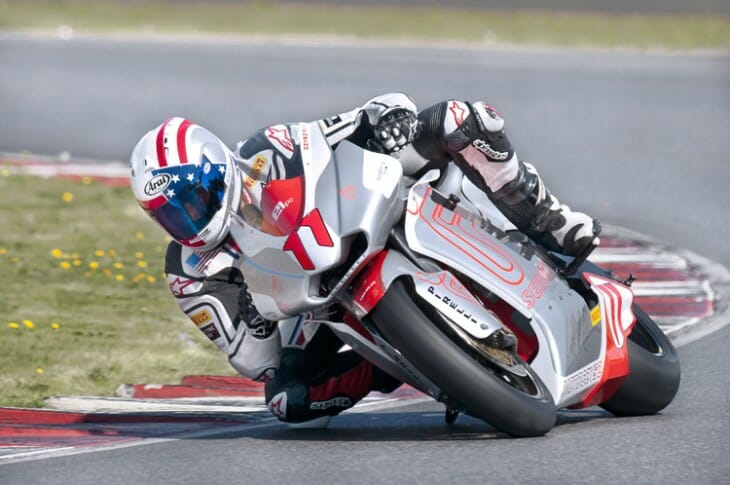Alan Cathcart | May 9, 2016
 Czysz, much like his hero John Britten, was a self taught engineer who refused to compromise on design.
Czysz, much like his hero John Britten, was a self taught engineer who refused to compromise on design.
Portland, Oregon-based design visionary Michael Czysz passed on May 7 aged 52, after a long fight with a rare and aggressive form of cancer. He was an innovative two-wheeled free-thinker whose motorcycles ultimately enjoyed serial success on the Isle of Man TT. Yet in a decade of thinking outside the box in terms of design, Czysz confronted two completely different engineering challenges – firstly, a prototype MotoGP racer done differently, then what are widely regarded as the most successful electric road racers yet built.
In a previous life before motorcycles, Michael Czysz acquired fame and fortune during a 20-year career as one of America’s top architects through his Architropolis design firm, in designing Las Vegas hotels and nightclubs, and creating homes for A-list celebrities like Cindy Crawford and Lenny Kravitz.
But from there to contriving an avantgarde alternative to conventional two-wheeled wisdom, was a big step – as manifested by the clean-sheet conception, and construction, of the four-cylinder 16-valve 1000cc C1 MotoGP engine with twin contrarotating cranks which first appeared in 2004. Set lengthways in a carbon fibre chassis equipped with radical front and rear suspension solutions, this was entirely concocted courtesy of Czysz’s own creative resources. Considering that he had zero formal training in mechanical engineering, Michael Czysz’s development of the bike bearing his name was an undertaking worthy of John Britten – who was indeed the inspiration to create the C1, according to Czysz.
 Czysz carves some lines on his C1 MotoGP prototype.
Czysz carves some lines on his C1 MotoGP prototype.
However, MotoGP’s reduction in capacity to 800cc for 2007 spelt the end of the C1 project, and after fruitless negotiations with companies in Japan, Austria and India about turning it into a Superbike, Czysz aborted mission and transferred his R&D talents to what he identified as the next big thing, electric bikes.
The swoopy-looking silent-running succession of MotoCzysz E1pc – as in, politically correct! – E-bikes proved to be the performance paragons among the new wave of zero emission road racers developed in the wake of the first TTXGP race for such devices held in the Isle of Man in 2009. The first hurriedly-produced MotoCzysz E1pc had a troubled debut in that event, but one year later in 2010 MotoCzysz returned to triumph in the race held over a single lap of the legendary 37.73-mile Mountain Course, with American TT racer Mark Miller riding it to victory at an average speed of 96.82mph from a standing start. This was the first TT win by an American motorcycle since Indian back in 1911, and the first ever by a bike and rider both from the USA. One month later, it was the turn of Michael Czysz himself – no mean racer, and an instructor at the Kevin Schwantz Riding School – to take his TT-winning electric racer to victory at Laguna Seca in the inaugural FIM e-Power race staged alongside the U.S. MotoGP.
This success gathered sponsorship from electric two-wheeled manufacturers Segway to return to the Isle of Man in 2011. This time, the aim was not only to score a repeat victory, but to gain added prestige by setting the first-ever electric-powered 100mph lap, with the attendant £10,000 bounty awarded by the Isle of Man Government for such an achievement. To better the chances of achieving this, Czysz brought a second 011 E1pc bike for British TT veteran Michael Rutter, who duly won the race with teammate Miller second, but narrowly missed out on the cash bonus by lapping at ‘just’ 99.60mph.
 The He certainly had the style! Czysz was a man who could ride just as well as design motorcycles.
The He certainly had the style! Czysz was a man who could ride just as well as design motorcycles.
For 2012, Czysz returned to the TT for a fourth time, again with Segway’s support, for Rutter and Miller to race a brand new pair of slim, svelte 012 E1pc bikes which manifested the considerable attention he’d meantime paid to aerodynamics. The growing global interest in zero emission racing was underlined by the presence of entries from two Japanese teams, one ridden by TT ace and current outright lap record holder John McGuinness. McGuinness was racing a bike named the Shinden – after the Japanese god of electricity – that had been created and entered by Honda’s blue sky R&D partner Team Mugen. But it was the American E-racer that again came out on top, with Rutter crossing the line 23.52sec ahead of McGuinness to win again at an average speed of 104.06mph, fast enough to write his name and that of MotoCzysz in the TT record books. Rutter thus collected that 10 grand cheque, which he duly shared with teammate Miller, who finished third, with all three riders breaking the 100mph barrier. Czysz returned in 2013 for Rutter to score a fourth successive victory for the team, defeating Mugen-mounted McGuinness for the second year in succession, albeit by the narrow margin of just 1.67secs. But it was on returning home from this triumph that Michael Czysz was diagnosed with the illness that has now taken him from us – another, much sadder feature of his life shared with the late John Britten.
Michael Czysz was a true Renaissance man, one who combined aesthetic artistry with a talent for engineering, in a variety of disparate fields. If the late Massimo Tamburini was the Michelangelo of motorcycling, then Czysz was a two-wheeled Leonardo da Vinci, whose capacity for innovation and eye for beauty was matched by his determination to break down the barriers of two-wheeled convention. Like his hero John Britten, Czysz was a radical revisionist, a self-taught engineer with the capacity to smash the mould of two-wheeled design convention, in favour of creating something completely unique and technically innovative, which delivered success on the racetrack. He was indeed a motorcycle visionary, a man unprepared to brook compromise, and a hard taskmaster who nevertheless inspired devotion in others sharing the joint pursuit of avantgarde technology.
Our heartfelt sympathies for Michael’s loss go to his wife Lisa, and sons Enzo and Max.
 At just 52, this was a man taken before his time.
At just 52, this was a man taken before his time.